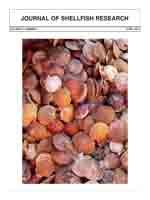This study determined the growth and biochemical composition of blue mussels (Mytilus edulis) reared on effluent from Atlantic cod (Gadus morhua) and compared it with mussels reared on a standard shellfish diet. Feeding trials lasted 6 mo, and mussels were sampled on a monthly basis. Dry weight, ash-free dry weight, shell length, and condition index were all significantly higher in algae-fed mussels at the end of the experiment compared with effluent-fed mussels. The carbon content decreased for mussels fed both diets; however, their nitrogen and protein content increased, with effluent-fed mussels having significantly more nitrogen and protein than algae-fed mussels, suggesting that effluent can increase mussel growth. Total lipid and fatty acid (FA) content decreased for effluent-fed mussels at the end of the experiment. There were no significant differences in the lipid class composition between mussels fed the 2 diets. Mussels fed both diets significantly decreased in the amount of 14:0, 16:1ω;7, 16:2ω;4, 16:4ω;1 and 20:5ω;3, and effluent-fed mussels also decreased in 18:4ω;3 and 21:5ω;3, as well as increased in the amount of 17:1, the Zooplankton markers 20:1ω;11 and 22:1ω;11, and the dienoic nonmethylene-interrupted fatty acids (NMIDs) 20:2a and 22:2b. Significant differences in the amount of individual FAs between mussels fed the 2 diets included a larger amount of 18:2ω;6 and 20:4ω;6 in algae-fed mussels, and a significantly larger amount of 16:4ω;1 in mussels fed effluent. Mussels fed both diets underwent significant increases in the proportion of bacterial FAs, ω;6 FAs, Zooplankton markers, and NMIDs. Effluent-fed mussels had a significantly larger proportion of monounsaturated FAs, Zooplankton markers, and NMIDs, as well as a smaller proportion of polyunsaturated FAs, and ω;3 and ω;6 FAs than algae-fed mussels. The increased presence of Zooplankton markers supports the use of these FAs to track aquaculture wastes.
How to translate text using browser tools
1 April 2012
Growth and Biochemical Composition of Mytilus edulis When Reared on Effluent from a Cod, Gadus morhua, Aquaculture Facility
Adrianus Both,
Christopher C. Parrish,
Randy W. Penney
ACCESS THE FULL ARTICLE

Journal of Shellfish Research
Vol. 31 • No. 1
April 2012
Vol. 31 • No. 1
April 2012




